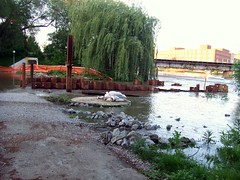The Story of the UI Cofferdam
 On March 8th, 2007, the University of Iowa embarked upon the North Chilled Water Crossing Project. The purpose of the project was to bring chilled water from the west side of the Iowa River over to the east side in order to provide additional cooling capacity for new building renovations and construction. Little did they know that this supposed 2.5 month project, due to be completed by June of 2007, would become fuel for the already raging disaster flood conditions in the summer of 2008.
On March 8th, 2007, the University of Iowa embarked upon the North Chilled Water Crossing Project. The purpose of the project was to bring chilled water from the west side of the Iowa River over to the east side in order to provide additional cooling capacity for new building renovations and construction. Little did they know that this supposed 2.5 month project, due to be completed by June of 2007, would become fuel for the already raging disaster flood conditions in the summer of 2008.
Problems with this project began shortly after it started and over one year later, the project was still not completed. The project involved building a cofferdam in the Iowa River to create a dry area for workers to install chilled water pipes under the river. Here is a rough timeline of events:
- 2006 - University approves the North Chilled Water Crossing Project with a $7 million budget
- March 2007 - Work begins on construction of the cofferdam
- May 16, 2007 - The cofferdam collapses in the Iowa River and workers narrowly escape harm
- June 2007 - Engineers evaluate the situation and begin making plans to repair the collapsed dam
- July 2007 - High waters impede work on the project and work carries on into the fall and winter months
- March 2008 - Crews are still working to evaluate, fix and stabalize the cofferdam. Officials are "relying" on good weather to get the project completed.
- June 2008 - It becomes evident that Iowa City will face a major flood event along the lines of the 1993 floods
- June 9, 2008 - As the waters top the spillway at the Coralville Dam, University of Iowa officials inform the public that the cofferdam is severely restricting flow in the Iowa River near the University. Businesses and residents upstream from the Dam will suffer even higher waters as a result. Some predictions say that flood waters could be up to 5 feet higher than normal because of the obstruction caused by the cofferdam.
- June 11, 2008 - Crews work to fortify the cofferdam from another collapse due to the approaching record flows in the Iowa River.
- June 13, 2008 - Flood waters rage and unprecidented flooding and damage to properties occurs in Iowa City and Coralville upstream from the cofferdam. Some buildings are in 5 - 6 feet of water. Many damaged properties were without flood insurance, and some are blaming the cofferdam as a contributor
